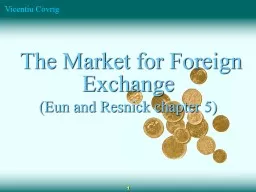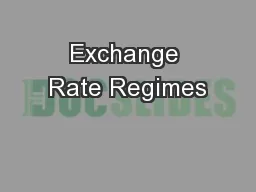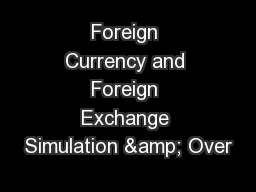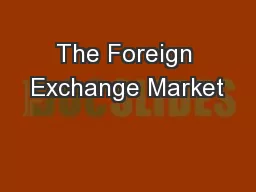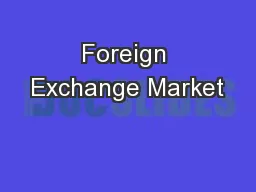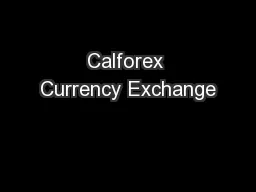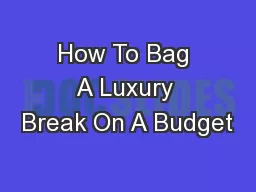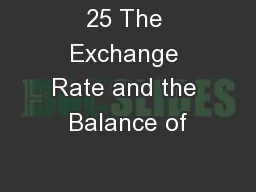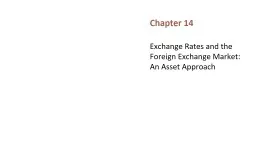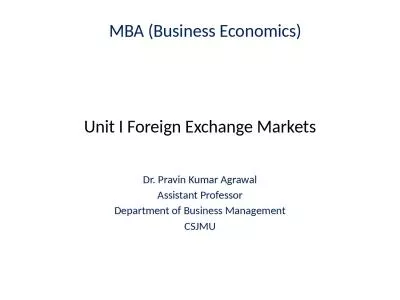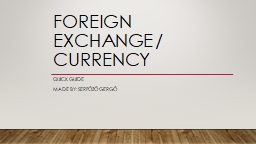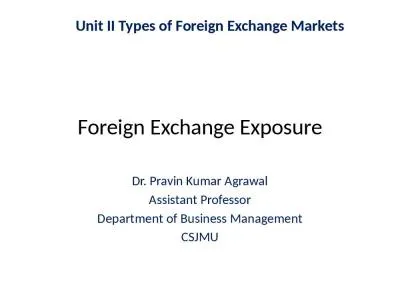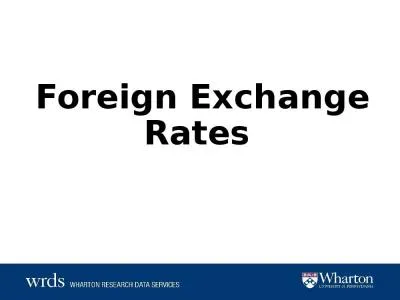PPT-The Market for Foreign Exchange
Author : phoebe-click | Published Date : 2016-08-14
Eun and Resnick chapter 5 FX Market Participants The FX market is a twotiered market Interbank market wholesale About 100200 banks worldwide stand ready to make
Presentation Embed Code
Download Presentation
Download Presentation The PPT/PDF document "The Market for Foreign Exchange" is the property of its rightful owner. Permission is granted to download and print the materials on this website for personal, non-commercial use only, and to display it on your personal computer provided you do not modify the materials and that you retain all copyright notices contained in the materials. By downloading content from our website, you accept the terms of this agreement.
The Market for Foreign Exchange: Transcript
Eun and Resnick chapter 5 FX Market Participants The FX market is a twotiered market Interbank market wholesale About 100200 banks worldwide stand ready to make a market in foreign exchange. In a forward transaction the terms of the purchase buy or sell are agreed up front but will take place on a date in the future thus the exchange rate is fixed now for a future exchange of currencies Forward transactions are commonly known as forward Two polar cases. Fixed (pegged) exchange rates. CB buys or sells reserves to maintain a set price of foreign exchange. Flexible exchange rates. CB does not intervene in market for foreign exchange. and . International Trade. Foreign Exchange Rates. (AKA FX or . forex. ). What are exchange rates?. The price of a currency in terms of another - the rate . at which one currency can be exchanged for . another (multiply foreign price by exchange rate to calculate). Ms. Faith . Moono. . Simwami. mo.simwami@gmail.com. 1. The Foreign Exchange Market. This . is . an organizational/institutional framework through which one currency is traded for another. This market serves a number of functions including the following. “Copyright and Terms of Service. Copyright © Texas Education Agency. The materials found on this website are copyrighted © and trademarked ™ as the property of the Texas Education Agency and may not be reproduced without the express written permission of the Texas Education Agency, except under the following conditions: . While budgeting may not be something you are naturally inclined to do, if you are planning for something like a vacation that has the potential to rack up hundreds of dollars in expenses, it is often the most sensible option, particularly if you are not in a high earning bracket or have other daily costs and expenditures to consider. While the word ’luxury’ can mean different things to different people, when it comes to a luxury vacation or short break away, most will agree that only a plush hotel or resort will qualify, and the term ‘budget’ is never usually used in the same sentence as the word ‘luxury’. However, for those of us who dream of splashing out on a no expenses spared vacation, but don’t have the funds to do so, is it worth doing a little research to see if there any ways to get a little luxury while on a budget? Payments. Learning Objectives. How the exchange rate is determined. Trends and fluctuations in the exchange rate. The effects of alternative exchange rate policies. Causes of international deficits and surpluses. Table 14-1: Exchange Rate Quotations. Value of $1.00. Domestic and Foreign . C. urrencies. In these lectures, . domestic currency. refers to the US dollar. Foreign currency . refers to the Euro, or at times to the Yen or the Yuan. La gamme de thé MORPHEE vise toute générations recherchant le sommeil paisible tant désiré et non procuré par tout types de médicaments. Essentiellement composé de feuille de morphine, ce thé vous assurera d’un rétablissement digne d’un voyage sur . Dr. . Pravin. Kumar . Agrawal. Assistant Professor. Department of Business Management. CSJMU. MBA (Business Economics). Foreign Exchange Market . Foreign exchange market is the market in which foreign currencies are bought and sold. This market is also termed as Currency, FX, or . Quick guide. Made by: . Serfőző. . Gergő. Definitions: . Currency:. a system of money in general use in a particular country.. Forms:. cash (bills, coins) . Foreign currency account: . A foreign currency account is a bank account in the currency of another country (e.g. a dollar account in the UK).. Dr. . Pravin. Kumar . Agrawal. Assistant Professor. Department of Business Management. CSJMU. Unit II Types of Foreign Exchange Markets. Foreign Exchange . E. xposure. Foreign exchange exposure . is a measure of the potential for firm’s profitability, net cash flow and market value because of a change in exchange rates. . After completing this assignment, students will:. Understand factors that can affect the value of a currency’s exchange rate. Foreign Exchange Rate. Currencies are continuously traded on foreign exchange markets; dealers adjust to changes in supply and demand, and the prices change accordingly..
Download Document
Here is the link to download the presentation.
"The Market for Foreign Exchange"The content belongs to its owner. You may download and print it for personal use, without modification, and keep all copyright notices. By downloading, you agree to these terms.
Related Documents

